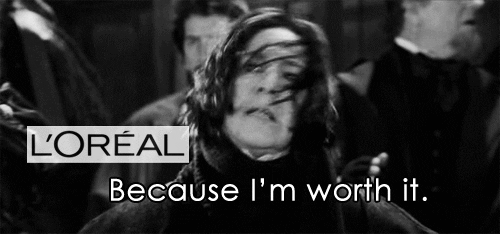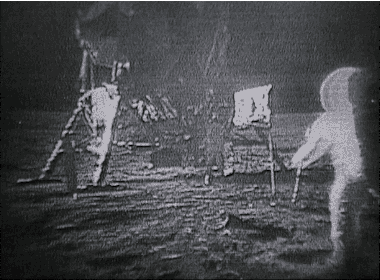Every creative student on earth has the same issue—"how the fuck do I price my work?"
See that GIF above? Well that could be you, rolling in the money—even if you aren't an Indian lady! (mad right?) It just requires you run over a couple of steps through your head and don't sell yourself short; even though it seems very fair to do so at the time.
Preface: Almost every creative subject studied at university will cover the chance for you to get some freelance work and unfortunately almost every single subject is not respected as 'real work'.
Every man and his dog would love branding for his god-awful business, every millennial wants illustration on their walls and for some reason everything needs a website now-a-days.
See here.
The only problem is, the majority sees these as 'non-essential' and don't really want to part cash with something they reckon they "could do themselves". Every early creative knows this in the back of their mind and the majority of clients know it too. They know you don't have the piece of paper that says BA(Hons) yet, so it's fair game as far as they're concerned.
So lets me share a couple of tips with you, to help you understand how to price yourself.
Freelance doesn't mean free of charge: This seems really REALLY obvious right? WRONG!
I haven't really encountered it myself but there is a large percentage of people that will see the word free and instantly assume the above.
Exposure doesn't buy beers: "This would be great exposure for you!"
Yeah man, a logo I designed hanging above your estate agents without any credit to myself will be great for my career—hey, let me do this for free for that privilege!
NO x 1000 – It might work well in my portfolio, but I could just create any logo ever, for my portfolio, so this is not a valid outcome. Pay me or leave me.
Charities, non-profit and work without pay: When it comes to work of this sort you need to ask yourself two questions.
Did whomever is asking for free work approach you or did you approach them? It's a question or morals really. If they approached you, they are looking for free work and will likely be a nightmare to work with. If you approached them, then you are offering a service with gratitude.
And secondly Does the person you are creating work for get paid for this? if they are getting paid from your hard work, then you've been ripped off—but if they aren't being paid and you two are both working payment free, then perhaps you are just being helpful.
Working by the hour: A difficult choice, with no real easy answer.
If you are an illustrator or artist alike, don't you dare think about working by the hour; whereas with design you can justify working by the hour because it's easier to predict the time it might take to do most jobs, especially if you've done them before.
With that said, I suggest you avoid doing so if you can. Use it as an idea for pricing but don't hing on working by the hours unless you've got a solid contract that allows for changes and cancellations.
Rights, terms and usage: Though you might not have thought about it too much—where, how and how long the work you are creating will be used, changes how you should price it.
Student doesn't mean cheap: You might not know everything but that doesn't mean you aren't the right person for the job; don't allow yourself to get into the mindset of 'I'm a student, so this is too much' though, I got my main freelance experience producing posters for £20 each. My time and work was worth more than this, but they were so frequent that the learning from the work was worth the sacrifice in money. It's a difficult decision but I reckon you might know when you see one.
You're worth more than you think: No explanation needed.
The PPP: (Practical Pricing Process)
Guideline Prices
- Student £10 per hour
- Graduate £15 per hour
Use these as guidelines to raise your price, lower your price or estimate a cost without working by the hour. I am not an expert but I find whenever anyone else does one of these they don't actually talk figure so it doesn't help any one. It's worth considering that you may want to reduce these figures if you are doing work that you aren't knowledge on or raising it if it's work that you are confident with.
Time
- A long deadline? Lucky you! (+0%)
- A short deadline (+10%)
Do you have years or minutes?
If you have a long time you needed price for extra hours, it just means you have more time to ponder and return to it; but on the other hand if you have nearly no time at all the complete the project, then you need to raise that price because you are making it priority number one.
Client
- Local Business (+0%)
- Large Business (+10%)
- Charity or Non-Profit (-20%) Just to be nice
When pricing it's best to understand who you are pricing for and how this will effect the work you produce. If it's a local business it might just go in their window, but if it's a larger company it could go on billboards and be circulated for years.
Costs
- Are you printing?
- Do you need to buy anything for the client or the project?
Don't cut yourself short, if you need 200 meters of silk to complete the project, make sure to add the cost of that alongside the pricing of the work.
Changes
Changes take time, time costs.
When pricing make sure to allow time and costs for changes; but be lenient. It's okay to allow three changes but when it comes to changes everyday, adding extra items or changing the whole project—you need to price accordingly. THIS IS IMPORTANT because the client will not always see things the way you do and is best outlined in the contract.
Contracts
It seems cold, but there is little to no reason to not work with a contract with your client. It gives you both security with the work and lets you know where you both stand.
Deposit
- Under £100 (No Deposit)
- £100 – £400 (33%)
- £500 + (50%)
Deposits allow safety on both sides. If the client drops out you haven't lost hours without pay and vise versa the client knows you aren't just going to drop out on them. It also means you can survive whilst working on the project.
Disclaimer: Though I have done my fair share of Freelance, I've only been doing this for three years so take my words as a guideline more than anything. You'll know when you see the worth which of these apply and which don't. You'll under sell yourself and you'll get screwed over—this happens to everyone.
You'll lose work and you won't always get it right. The hardest part of being a creative is being paid for it (until you hit the big leagues) so stick at it!

































